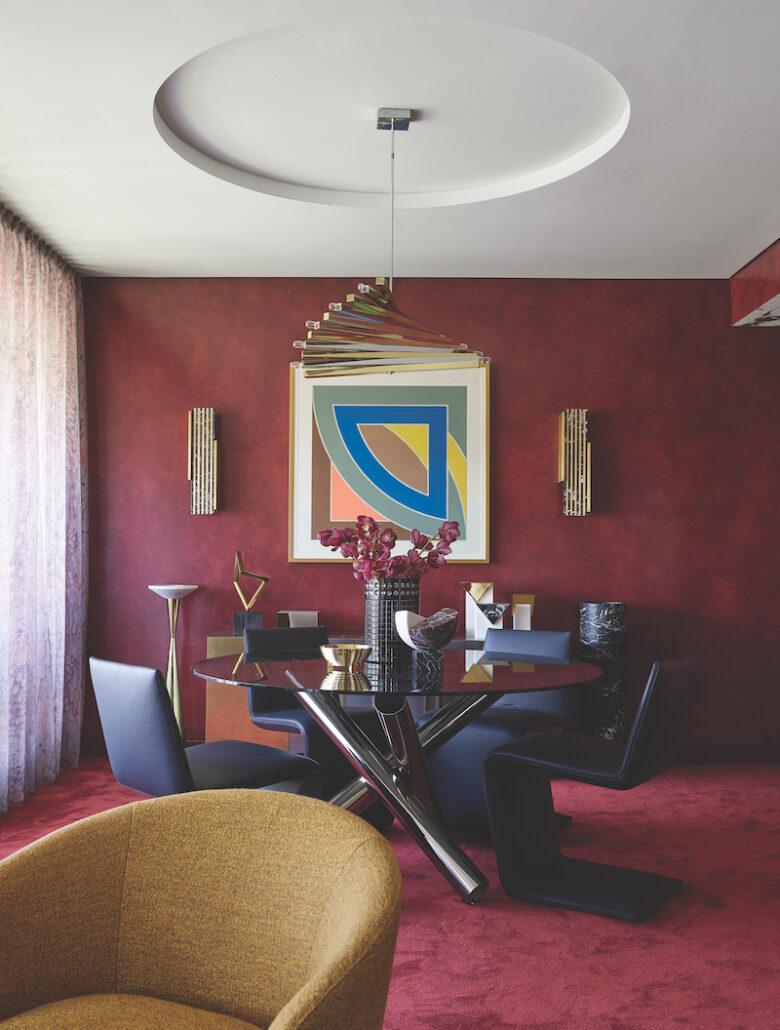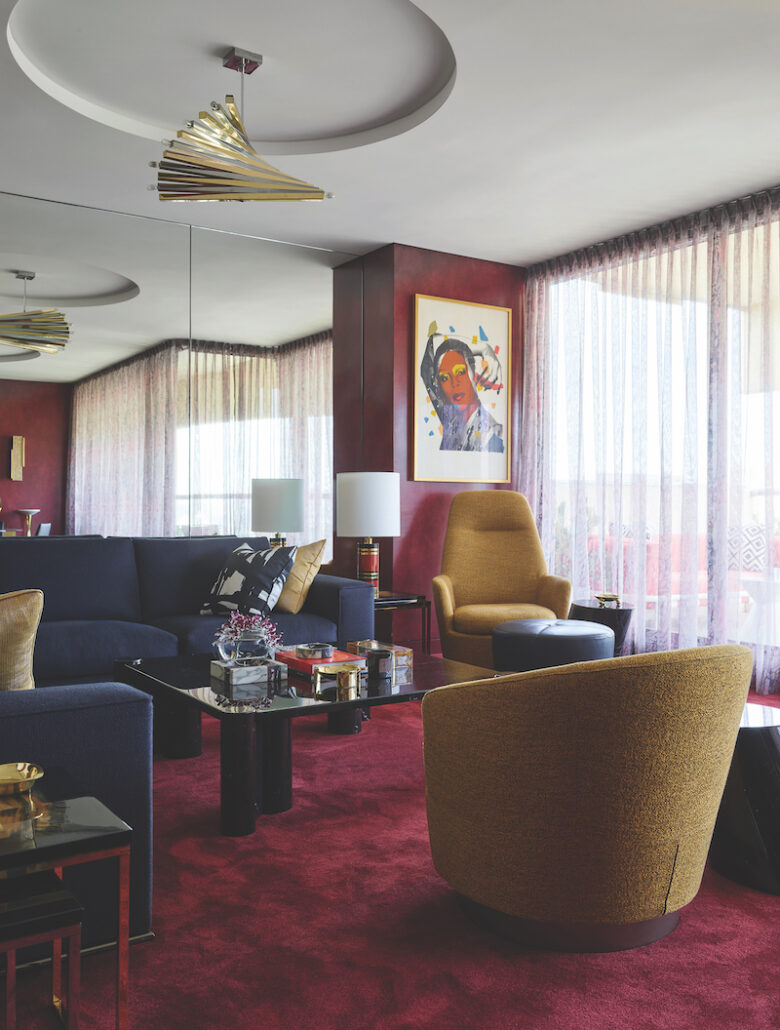In the 1980s, the late Australian architect Harry Seidler designed Sydney’s iconic 43-storey Horizon Building with the aim that it would, upon completion, represent the future of high-rise living. It has seen many a resident come and go, each bringing their unique vision to the residential spaces within it. Presently, one of these spaces is enjoying its third interior redesign.
Simply named the Darlinghurst Apartment, the home which now belongs to Australian designer Greg Natale and his partner Jason Greenhalgh began its story as one characterised by softness. “The first iteration,” says Natale, “was white and green,” with delicate furnishings meant to inspire ease. But this did not last. With inspiration drawn from their many trips to Paris, the Darlinghurst Apartment took on a new layer, then another, and now a latest third.
Today, with its eye to the harbour at Sydney’s horizon, it gives its opulence over as a lens through which to appreciate Natale’s ever-evolving vision for the future of his and his partner’s home. “It’s been an ongoing, ever-changing project,” explains Natale, beginning the journey through his home with humble introspection. “I find it rather challenging to design for myself.”
How much easier it was, then, that the first seed of inspiration for the dominant hue of the home should come from Greenhalgh. “Jason came up with the idea for maroon carpets while we were visiting Paris; you see similar indulgent crimson carpets all over the city.” Marrying this with his love of the disco aesthetic and taking inspiration from Studio 54 – a former disco nightclub in New York City – it is only fitting that the entrance of the home bear a maroon-on-maroon palette. It is as immersive as it is hypnotic, awing the friends and family they love to host and drawing them into the warmth of their apartment.
Contrasting textures draw the eye immediately. Light pouring through the hall from the windows ahead tug on curiosities and feet. But the eye has so much yet to see: custom furniture and fixtures designed by Natale himself, various vintage and contemporary accessories, and, of course, the art.
An expansive floor-to-ceiling mirror gives the illusion of space, such that the immensity of texture and colour remain balanced alongside one another as our gaze floats upward off the plush carpet to the gold seams adorning the marble ceilings. In the mirror’s reflection hangs one of Sydney Ball’s abstract, geometric pieces from his 2014 INFINEX III series, its hard edges and bright colours striking against the maroon wall. From there we shift over to the left, beholding one of 10 screen-prints from Keith Haring’s Apocalypse series, its gilded frame seeming almost like a part of the ceiling.
“I’ve always loved Keith Haring’s work,” Natale says, “and this piece is quite layered.” All 10 pieces from the Apocalypse series are joined with text by American writer William S. Burroughs, pairing tales of the end times as metaphors for the 1980s AIDS epidemic that claimed the lives of many, including Haring’s. The artwork sits as homage to the significance of queer history. Beside it on a custom Hercules Plinth is Dan Murphy’s silver and gold Brains’ Song sculpture, lending contrast both in style and story.
Art within the home came to fill the space over time, and so their stories evolved too, enhanced or softened by virtue of the pieces sitting alongside them. “Our collection has been growing and expanding over several years. Previously, when the walls and carpet of the apartment were white and gold, we displayed artwork with bolder, brighter colours,” Natale describes. “Now, we’ve worked to acquire pieces with slightly more muted colours relative to the artworks we had before. It’s all about selecting artworks that enhance the interior rather than take from it.”
One of the standout pieces in the dining room is a 70s metallic cabinet Natale describes as “spectacular”. Above it hangs River of Ponds 1 by Frank Stella, a vibrant piece similar to Ball’s in that its sharp, bold colours pair with unexpected harmony against its nebulous maroon backdrop, and the custom wall sconces hanging at its sides. Opposite this piece in the living room is the iconic 135 artwork from Andy Warhol’s 1975 Ladies and Gentlemen series. Featuring abstract portraits of real drag queens and trans women living in New York, it, as Natale explains, champions members of the queer ballroom scene during a pivotal time in queer politics.
Returning to the disco-inspired aesthetic of Studio 54 and the 70s is the two-tone silver and gold in the bedroom. A piece by Romeo Rega, an Italian designer whose work is synonymous with 70s design, shares a space with the RETNA, a contemporary work which Natale purchased in Los Angeles. “I love this modern, hieroglyphic design that he does. He started as a street artist and was a pseudo godchild of Haring’s, and so owning a piece by each artist is like a visualisation of the progression of that iconic New York graphic style I love.”
Like the design of the home itself, the stories told by the artworks exist at the binaries that are unexpectedly beautiful alongside one another. Where some speak poignantly to tragedy, others celebrate history and the ever-evolving inspiration the world offers Natale and Greenhalgh. Bold and unapologetically layered, it speaks to the curation of moments in time that make it a truly personal space. “Design is an extension of the self,” they both say, with Natale adding, “It’s all these different cogs turning together to make something larger than life.”
The Darlinghurst Apartment is a true manifestation of this metaphor. It is a place that, with each breath, welcomes the daring experimentation of its inhabitants and the new layers its future will surely bring.
Above: Greg Natale in the entrance lobby of his Darlinghurst apartment building, which features a mural by American artist Sol LeWitt, Bars of Colour.

Displayed in the entrance is one plate of 10 serigraph’s comprising Keith Haring’s Apocalypse series, along with a Brian’s Song sculpture by Dan Murphy.

Against the striking maroon backdrop, original Frank Stella lithograph River of Ponds is displayed in the dining room between two custom marble and bronze wall scones above a Minotti table featuring original Greg Natale accessories.

The hero of the living room, the Jumbo Coffee Table, designed by Gae Aulenti for Knoll, is adorned with Greg Natale accessories that speak to the Andy Warhol screenprint #135 from his Ladies and Gentlemen series.

In the guest bedroom hangs 11.31: Marilyn Monroe, a silkscreen print reproduction of Andy Warhol’s diptych of the actress by Sunday B. Morning from when the artist collaborated with the printing company in 1970.

